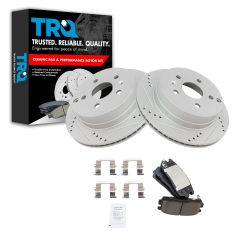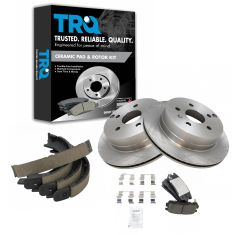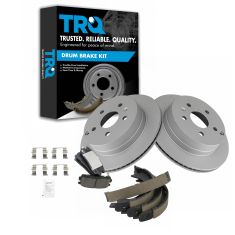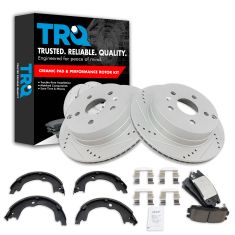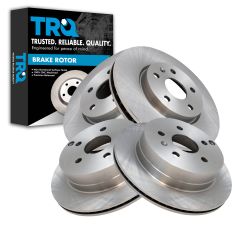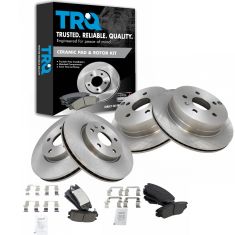1ABFS02601-2010-17 Chevrolet Equinox GMC Terrain Rear Ceramic Brake Pad & Rotor Kit TRQ BKA11738
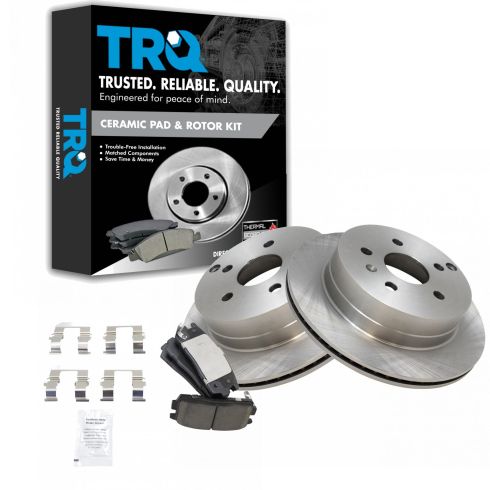
Replaces
2012 GMC Terrain Rear Ceramic Brake Pad & Rotor Kit TRQ BKA11738

Product Reviews
Loading reviews
4.90/ 5.0
21
21 reviews
Fast shipping great nproduct for a really good price
April 9, 2018
Nakamoto makes high quality brake pads and calipers. I replaced my front ones in November and the are holding up well, I just replaced the rears and so far so good
October 29, 2018
Good parts, good prices, and the videos were a lot of help! Thanks 1-A.
Great brake products.
November 18, 2018
I replaced the front brakes on my 2011 Equinox about a year ago and paid a little over $200 for pads and rotors from my local parts store. When it came time to replace the rear brakes, I searched around for better deals, (not just the cheapest) and came across your website. I got the pads and rotors shipped to me for around $75. Plus the technical videos were very helpful. I replaced the rear brakes, both sides in about 1.5 hours. And speaking of quality, these parts appear to be better quality than the parts I bought locally last year. My only regret was not finding A1 Auto a year ago.
Fast delivery
May 19, 2019
I received my parts in 3 days. They seem to be very good quality for the price. Was exactly what I needed.
Concerned for nothing
September 6, 2019
As I was shopping around for the parts to replace the rear brakes and rotors on oyr 2012 GMC Terrain, I have to admit it was a bit unnerving to find 1AAuto not just cheaper, but cheaper by 75% than other suppliers. I mulled over the decision to place my family's safety in the hands of this "bargain". But, soley on the premise that if the parts failed early, I would not be out all that much, I ordered the parts. Upon arrival, I discovered the partd were from China, which again gave me a shot of concern, but they looked fine, fit perfectly and thus far have performed every bit as well as the factory parts. I think 1AAuto and I will be long term friends. It would appear I was concerned for nothing.
Very Happy ??
September 25, 2019
I was very happy. I have told friends who have already ordered from you guys. I will be doing business again soon for my truck..
Fast delivery and great price
November 30, 2019
Order came very quickly, I could not beat the prices!
Robert
March 23, 2020
Everything fit like original. Parts arrived early. Very satisfied with the service.
ceramic brake kit front and back
April 26, 2020
Very good product works real well and was delivered and a timely fashion
Up grade
November 2, 2020
Nothing to dislike, fast shipping great products easy installation. I'm ready to order up grades for the front.
Would buy again
July 27, 2021
Parts arrived in a timely manner
Fit perfectly
A1 auto videos of how to do were a big help
August 9, 2021
Great parts and good price
Good brake kit
October 25, 2021
Good brake and rotors for the money. So far no problems.
2014 equinox brakes
February 27, 2022
Product was the way I expected
Shipping time was very good
I installed it myself, very usefull installation videos on youtube
April 3, 2022
Ive been using this brand for a while. Always quality. Fast shipping.great experience.
Very satisfied
August 25, 2022
Top quality parts at a great price. Excellent support and communications, too. Videos are a big help.
June 27, 2023
Excellent parts
August 23, 2023
Great
Work well
October 22, 2023
Brakes went on easy and work well.
March 10, 2024
Everything was perfect as described
Muchas gracias
[{"url": "https://wac.edgecastcdn.net/001A39/prod/media/pNISJll75W64CYGsite/308b750dfd28d4a96716e88a1be0b663_1714245867869_0.jpeg", "caption": "RPIDO Y SEGURO RECOMENDADO"}]
April 27, 2024
El envo fue muy rpido estoy muy agradecido en excelentes condiciones 100% recomendado
Customer Q&A
No questions have been asked about this item.
GMC is a registered trademark of General Motors Company. 1A Auto is not affiliated with or sponsored by GMC or General Motors Company.
See all trademarks.








